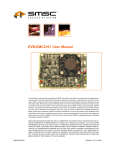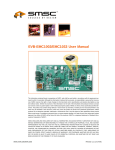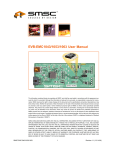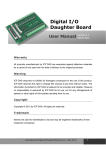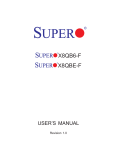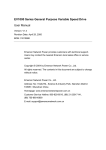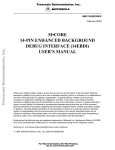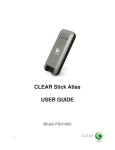Download EVB-EMC14XX User Manual - SMSC
Transcript
EVB-EMC14XX User Manual The information contained herein is proprietary to SMSC, and shall be used solely in accordance with the agreement pursuant to which it is provided. Although the information is believed to be accurate, no responsibility is assumed for inaccuracies. SMSC reserves the right to make changes to this document and to specifications and product descriptions at any time without notice. Neither the provision of this information nor the sale of the described semiconductor devices conveys any licenses under any patent rights or other intellectual property rights of SMSC or others, unless specifically specified otherwise. The product may contain design defects or errors known as anomalies, including but not necessarily limited to any which may be identified in this document, which may cause the product to deviate from published specifications. SMSC products are not designed, intended, authorized or warranted for use in any life support or other application where product failure could cause or contribute to personal injury or severe property damage. Any and all such uses without prior written approval of an officer of SMSC will be fully at the risk of the customer. SMSC is a registered trademark of Standard Microsystems Corporation (“SMSC”). SMSC DISCLAIMS AND EXCLUDES ANY AND ALL WARRANTIES, INCLUDING WITHOUT LIMITATION ANY AND ALL IMPLIED WARRANTIES OF MERCHANTABILITY, FITNESS FOR A PARTICULAR PURPOSE, TITLE, AND AGAINST INFRINGEMENT AND THE LIKE, AND ANY AND ALL WARRANTIES ARISING FROM ANY COURSE OF DEALING OR USAGE OF TRADE. IN NO EVENT SHALL SMSC BE LIABLE FOR ANY DIRECT, INCIDENTAL, INDIRECT, SPECIAL, PUNITIVE, OR CONSEQUENTIAL DAMAGES; OR FOR LOST DATA, PROFITS, SAVINGS OR REVENUES OF ANY KIND; REGARDLESS OF THE FORM OF ACTION, WHETHER BASED ON CONTRACT; TORT; NEGLIGENCE OF SMSC OR OTHERS; STRICT LIABILITY; BREACH OF WARRANTY; OR OTHERWISE; WHETHER OR NOT ANY REMEDY OF BUYER IS HELD TO HAVE FAILED OF ITS ESSENTIAL PURPOSE, AND WHETHER OR NOT SMSC HAS BEEN ADVISED OF THE POSSIBILITY OF SUCH DAMAGES. SMSC EMC140X/2X 1 Revision 1.0 (12-14-06) EVB-EMC14XX User Manual 1 Overview The EMC140X series of devices are SMBus temperature sensors with THERM and ALERT outputs. The EMC142X series of devices have Hardware Thermal Shutdown outputs in place of THERM. The EMC1402 and EMC1422 each monitor one internal diode and one externally connected temperature diode.The EMC1403 and EMC1423 each monitor one internal diode and two externally connected temperature diodes. And finally, the EMC1404 and EMC1424 each monitor one internal diode and up to three externally connected temperature diodes. All of the modes and functions of the EMC140X/2X can be tested and observed with the EVBEMC14XX. The EVB-EMC14XX is a USB-based platform for evaluating all variations of the EMC140X/2X. A block diagram of this EVB is shown in Figure 1.1. 1.1 Related Documents The CD included with the evaluation board contains the following documents: n Evaluation Board Checklist n Bill Of Materials n Schematic n Jumper Settings and Connector List n Datasheets n Chip Manager Application n Chip Manager Register Definition Files (EMC1402.xml, EMC1403.xml, EMC1404.xml, EMC1422.xml, EMC1423.xml, and EMC1424.xml) Figure 1.1 EVB-EMC14XX Block Diagram Revision 1.0 (12-14-06) 2 SMSC EMC140X/2X EVB-EMC14XX User Manual 2 Getting Started 2.1 System Requirements To use the EVB you will need: 2.2 2.3 n A PC running Windows 2000 or XP n Display resolution 800x600 (or larger to view several windows simultaneously) n An available USB port Feature Summary n The SMSC Chip Manager (ChipMan) application allows viewing and changing register values n Graphing of any register n Headers for connecting a remote diode or CPU/GPU n Resistance Error Correction verification n Saving of settings of all registers allowing for quick loading at a later time n USB communication to evaluation board n An external SMBus master may also be used via jumper settings Installing the EVB 1. Install the Chip Manager application and device driver on a PC by running Setup.exe from the Chip Manager distribution CD. A revision history and install/un-install notes may be found in the readme.txt file on the disk. 2. Connect the supplied USB cable to an available USB port on the PC. Plug the “mini-B” end of the USB cable into EVB connector P6. The +3.3V and Bridge ACT LEDs should illuminate. After the EVB is connected to the PC the “Find New Hardware” wizard will pop up for USB driver installation. Follow the instructions in the readme.txt file to complete the installation process. 3. Start the EVB Software by selecting the Chip Manager application from the SMSC folder from the Programs Windows Start menu. The EVB will initialize and the Chip Manager Quick Help screen will appear as in Figure 2.1. The USBAct LED should be blinking when the Chip Manager is running. For more help with Chip Manager, select Help -> Contents for an html based help document as shown in Figure 2.2. Note: The SMSC Chip Manager application allows viewing and changing register values for a variety of EVBs including the EMC1001, EMC1002, EMC1023, EMC1033 and EMC2101. The Chip Manager software only needs to be installed once to support all of these EVBs. The list of supported EVBs may be found in the pulldown menu under Options -> Select Device. SMSC EMC140X/2X 3 Revision 1.0 (12-14-06) EVB-EMC14XX User Manual Figure 2.1 Chip Manager Quick Help Startup Screen Revision 1.0 (12-14-06) 4 SMSC EMC140X/2X EVB-EMC14XX User Manual Figure 2.2 Chip Manager Help Screen SMSC EMC140X/2X 5 Revision 1.0 (12-14-06) EVB-EMC14XX User Manual 2.4 Board Layout The EVB was designed for ease of use and user experimentation with easily accessible jumpers and access to the SMBus data lines. Figure 2.3 below shows the silk-screen for the EVB-EMC14XX. Figure 2.3 EVB-EMC14XX Board Outline and Silk-screen Revision 1.0 (12-14-06) 6 SMSC EMC140X/2X EVB-EMC14XX User Manual 3 Hardware Description 3.1 Introduction The EVB-EMC14XX provides the means to demonstrate all of the EMC140X/2X features and to view and modify registers. LEDs indicate status information and test points are included to monitor system voltages with a user provided voltmeter or oscilloscope. 3.2 EMC140X/2X Devices A total of four of six SMSC devices are on-board the EVB-EMC14XX. Jumpers enable which version is active on the EVB. Please contact SMSC for boards with the EMC1423 or EMC1424 devices. 3.3 USB to SMBus Bridge The USB to SMBus bridge is based on an 8051 micro controller with integrated USB and SMBus interfaces as well as internal flash and RAM. During EVB manufacture, firmware is loaded into the bridge that provides the interface between the USB and the SMBus. Power is sourced to the micro controller from the USB interface for device power and communication. 3.3.1 Direct SMBus Connect Option It is also possible to connect an external SMBus master to the EVB-EMC14XX. A few jumper settings are all that is required to drive the any one of the devices on-board the EVB: 3.4 n Simply remove the jumpers on JP6 and connect the SMBus master to the SCL, SDA and ALERT pins, as well as an external supply for +3.3V. n The +3.3V can be supplied by the SMBus bridge by leaving the +3.3V jumper in place and retaining the USB connection. Connecting to Remote Diodes This EVB is populated with jumpers to connect to an external diode or CPU/GPU. If connecting to a CPU’s thermal diode, it is necessary to provide a common ground. Also, it is usually necessary to bias the appropriate CPU Vcc plane above this common ground to avoid forward-biasing the ESD diodes with the temperature sensor signals. These connections have been provided on JP11 which is read by EMC1422. Consult the CPU manufacturer’s datasheet for guidance on interfacing to the thermal diode. Refer to the schematic EMC14XX_EVB_SCH-7092-A.pdf for details on the EVB header connections. 3.5 Resistance Error Correction (REC) The remote diode DN signal path has a 100 ohm series resistor to demonstrate the EMC140X/2X’s REC feature. See Table 3.3 for details on the REC jumper settings. 3.6 Power Source This EVB requires only one USB connection to power the entire board. The USB-SMBus bridge regulates the +5V USB power to +3.3V used by the EMC140X/2X and other EVB circuitry. 3.7 Test Points Test points are provided for: n Ground n +3.3V power n +5V_USB power n ALERT, THERM, and SYS_SHDN outputs SMSC EMC140X/2X 7 Revision 1.0 (12-14-06) EVB-EMC14XX User Manual 3.8 LED Indicators LEDs indicate the status of the following signals (Table 3.1). Table 3.1 LED Status Indicators LED SIGNAL OFF GREEN RED LED1 ALERT +3.3V power OFF No ALERT ALERT LED2 +3.3V +3.3V power OFF +3.3V power ON NA LED3 Bridge Activity NO Activity on USB/SMBus Bridge Activity on USB/SMBus Bridge NA LED4 USB Activity NO Activity on USB port Activity on USB port NA LED5 SYS_SHDN +3.3V power OFF No SYS_SHDN SYS_SHDN LED6 THERM +3.3V power OFF No THERM THERM LED7 ALERT/THERM +3.3V power OFF No ALERT/THERM ALERT/THERM LED02 EMC1402 power device OFF device ON NA LED03 EMC1403 power device OFF device ON NA LED04 EMC1404 power device OFF device ON NA LED22 EMC1422 power device OFF device ON NA LED23 EMC1423 power device OFF device ON NA LED24 EMC1424 power device OFF device ON NA 3.9 Jumper Settings This EVB has many jumper configurations to evaluate all of the features of the EMC140X/2X family of devices. The first jumper the user should connect is the device enable jumper. This jumper will determine which of the 6 devices will be powered up and evaluated. Table 3.2 Device Selection Jumpers DEVICE ENABLE DISABLE EMC1402 JP1: short 1-2 JP1: short 2-3 EMC1403 JP2: short 1-2 JP2: short 2-3 EMC1404 JP3: short 1-2 JP3: short 2-3 EMC1422 JP4: short 1-2 JP4: short 2-3 EMC1423 JP5: short 1-2 JP5: short 2-3 EMC1424 JP6: short 1-2 JP6: short 2-3 The remote diode on board the EVB-EMC14XX has an in-line series resistance adjustment. Checking the REC (Resistance Error Correction) feature of the EMC1402 is accomplished by setting the jumper on JP16 as shown in Table 3.3. An open jumper adds 100 ohms of series resistance to the DN line of the diode connection. To return to 0 ohm series resistance, replace the jumper on JP16. This feature Revision 1.0 (12-14-06) 8 SMSC EMC140X/2X EVB-EMC14XX User Manual is demonstrated on the EMC1402 only. However, each device of the EMC140X/2X family has this feature. Table 3.3 Resistance Error Correction JUMPER NAME OPEN SHORT JP16 REC 100 ohms in DN line (diode remote -) 0 ohms in DN line (diode remote -) This EVB also allows for an off-board diode to be tested (see Table 3.4). This is done by removing both jumpers of the device of interest. Then connect Pin 1 to the ‘remote+’ terminal of the remote diode and Pin 3 to the ‘remote-‘ terminal of the remote diode. Make sure a common ground exists between the remote diode (GPU, etc.) and the EMC140X/2X EVB. Also ensure that the remote diode is properly biased according to the diode manufacture. One remote connection is provided per EMC140X/2X device. Table 3.4 Remote Diode Configurations JUMPER JP7 JP8 JP9 JP10 JP13 JP14 JP15 CONFIGURATION PIN 1 On-board diode EMC1402 (Q1) Off-board diode (CPU, GPU, etc.) remote + / DP open remote + / DP remote - / DN remote - / DN short / DP open open short / DN open remote - / DN short / DP remote + / DP open short / DN open remote + / DP open short / DN short / DP On-board diode EMC1424 (Q12) Off-board diode (CPU, GPU, etc.) remote - / DN short / DP On-board diode EMC1424 (Q10) Off-board diode (CPU, GPU, etc.) remote - / DN short / DN open remote + / DP open short / DN open remote + / DP On-board diode EMC1423 (Q8) Off-board diode (CPU, GPU, etc.) remote - / DN short / DP On-board diode EMC1404 (Q6) Off-board diode (CPU, GPU, etc.) open remote + / DP PIN 4 short / DN short / DP On-board diode EMC1404 (Q5) Off-board diode (CPU, GPU, etc.) PIN 3 short / DP On-board diode EMC1403 (Q3) Off-board diode (CPU, GPU, etc.) PIN 2 open short / DN open remote - / DN open PIN 3 PIN 4 NA NA NA NA Table 3.5 EMC1422 Off-board Diode Connections CONFIGURATION On-board diode EMC1422 (Q7) SMSC EMC140X/2X JUMPER JP12 JP11 PIN 1 PIN 2 Short / DP Short / DN 9 Revision 1.0 (12-14-06) EVB-EMC14XX User Manual CONFIGURATION Off-board diode (CPU, GPU, etc.) Revision 1.0 (12-14-06) JUMPER PIN 1 PIN 2 PIN 3 PIN 4 JP12 Open Open NA NA JP11 remote + / DP remote - / DN Vbias GND 10 SMSC EMC140X/2X EVB-EMC14XX User Manual A unique feature of the EMC142X series of devices is the ability to select the Hardware System shutdown temperature based on the pull up resistor on the ALERT and SYS_SHDN outputs. The EVB allows the user to quickly evaluate each of the 36 temperature values by adjusting JP18 and JP17 as shown in Table 3.6. Table 3.6 ALERT and SYS_SHDN Resistor Selection for SYS_SHDN Temperature SYS_SHDN R53 JP18: 1-2 R54 JP18: 3-4 R55 JP18: 5-6 R56 JP18: 7-8 R57 JP18: 9-10 R58 JP18: 11-12 4.7K OHM ±10% 6.8K OHM ±10% 10K OHM ±10% 15K OHM ±10% 22K OHM ±10% 33K OHM ±10% R47 JP17: 1-2 4.7K OHM ±10% 77°C 83°C 89°C 95°C 101°C 107°C R48 JP17: 3-4 6.8K OHM ±10% 78°C 84°C 90°C 96°C 102°C 108°C R49 JP17: 5-6 10K OHM ±10% 79°C 85°C 91°C 97°C 103°C 109°C R50 JP17: 7-8 15K OHM ±10% 80°C 86°C 92°C 98°C 104°C 110°C R51 JP17: 9-10 22K OHM ±10% 81°C 87°C 93°C 99°C 105°C 111°C R52 JP17: 11-12 33K OHM ±10% 82°C 88°C 94°C 100°C 106°C 112°C PULL-UP ALERT PULL-UP SMSC EMC140X/2X 11 Revision 1.0 (12-14-06) EVB-EMC14XX User Manual 3.10 Default Jumper Settings Table 3.7 Default Jumper Settings JUMPER NAME CONNECTION JP1 EMC1402 Power 1-2 23 Turn off EMC1402 EMC1403 Power 12 Power on EMC1403 JP2 JP3 JP4 JP5 JP6 JP7 JP8 JP9 JP10 JP11/JP12 JP13 JP14 JP15 JP16 Revision 1.0 (12-14-06) EMC1404 Power EMC1422 Power EMC1423 Power EMC1424 Power DESCRIPTION Power on EMC1402 2-3 Turn off EMC1403 12 Power on EMC1404 2-3 Turn off EMC1404 12 Power on EMC1422 2-3 Turn off EMC1422 12 Power on EMC1423 2-3 Turn off EMC1423 12 Power on EMC1424 2-3 Turn off EMC1424 EMC1402 off-board diode 1-2 DP connection 3-4 DN connection EMC1403 off-board diode 1-2 DP connection 3-4 DN connection EMC1404 off-board diode 1-2 DP connection 3-4 DN connection EMC1404 off-board diode 1-2 DN connection for anti-parallel diode 3-4 DP connection for anti-parallel diode EMC1422 off-board diode JP12.1 - JP11.1 DP connection JP12.2 - JP11.2 DN connection JP11.3 Vbias ~ +0.7V JP11.4 Ground EMC1423 off-board diode 1-2 DP connection 3-4 DN connection EMC1424 off-board diode 1-2 DP connection 3-4 DN connection EMC1424 off-board diode 1-2 DN connection for anti-parallel diode 3-4 DP connection for anti-parallel diode REC 1-2* IN = 0 ohms, OUT = 100 ohms in 12 SMSC EMC140X/2X EVB-EMC14XX User Manual JUMPER NAME CONNECTION JP17 ALERT pull-up 1-2 Select 4.7k ohm resistor 34 Select 6.8k ohm resistor 56 Select 10k ohm resistor 78 Select 15k ohm resistor 9 10 Select 22k ohm resistor 11 12 Select 33k ohm resistor SYS_SHDN 1-2 Select 4.7k ohm resistor pull-up 34 Select 6.8k ohm resistor 56 Select 10k ohm resistor 78 Select 15k ohm resistor 9 10 Select 22k ohm resistor 11 12 Select 33k ohm resistor 1-2 +3.3V 3-4 SDA - SMBus 5-6 SCL - SMBus 7-8 ALERT JP18 JP19 JP20 USB to SMBus Flash Prog Header Note: dashed line indicates jumper position 3.11 Other Sensor Features NA DESCRIPTION Used in manufacturing Other features such as Ideality Factor Configuration, Conversion Rate, Digital Filtering, and Standby Mode can be controlled with EMC140X/2X registers. See the datasheet register description for details. SMSC EMC140X/2X 13 Revision 1.0 (12-14-06) EVB-EMC14XX User Manual 4 Software Description 4.1 Chip Manager Overview The Chip Manager (ChipMan) application initially displays the main Help screen, where detailed description of the application’s features may be found. The Help screens can be displayed at any time by selecting Help from the menubar. Chip Manager enables the user to display temperature readings, set temperature limits and read/write configuration register values. 4.2 Temperature/Register History Graph To open a Temperature or Register History Graph window, select the register or registers to plot in the Chip Manager application. then select Options -> Plot Register Data from the menubar. Once the graph appears, select Control -> Start to begin plotting data. The history plot continuously updates the register data reported by the EMC140X/2X. Figure 4.1below is a typical Temperature History with the external diode of the EMC1402 starting at room temp and then being heated by simply placing a finger on Q1.: Figure 4.1 EMC140X/2X Temperature History Graph Revision 1.0 (12-14-06) 14 SMSC EMC140X/2X Mouser Electronics Authorized Distributor Click to View Pricing, Inventory, Delivery & Lifecycle Information: SMSC: EVB-EMC14XX















